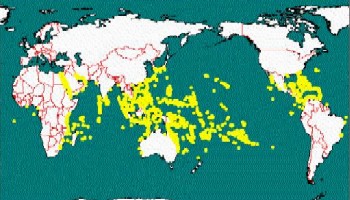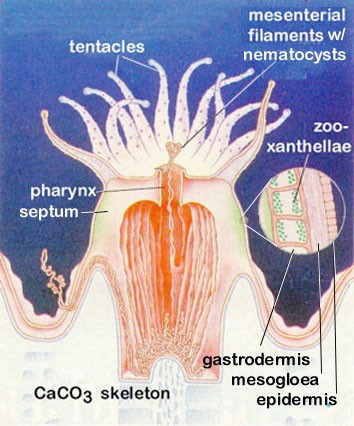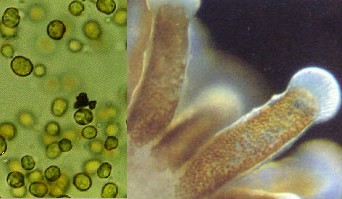|
Navigation
OCB3034
Main Page
FIU
Home
FIU
Marine Biology Home
Dept.
Biology Home
Frank
Jochem Home
E-Mail
|
Coral Reefs
-
Most
complex and diverse marine systems
-
Formed
by biological activity of corals belonging to the phylum Cnidaria (relatives
of jellyfish)
-
Oldest
marine communities, more than 500 million years (different species, though)
-
Cover
~600,000 km² in water >20°C (23-29°C opt.)

-
Salinity
requirement 32 - 42‰
-
Light
is required for coral growth due to symbiontic, photosynthetic zooxanthellae
(dinoflagellates); < 25 m water depth
-
Turbidity
by �sediments or �phytoplankton �affects coral �growth and �health
-
Corals
are related to benthic sea anemones, class Anthozoa, phylum Cnidaria
-
Reefs
are built of tiny individuals called polyps

-
Polyps
possess tentacles containing batteries of nematocysts to capture and paralyze
prey
-
Colonies
are created by asexual division called budding, and all polyps remain connected
by tissue
-
Polyps
secret calcium carbonate exoskeleton of �1-3 mm diameter, which forms the
base of the reef
-
Individual
colonies can range in size up to some hundred tons, and colony form depends
on species and environment (wave exposure)
-
Reef-building
(hermatypic) corals possess symbionts, which are already given in the planktonic
larvae

-
Non-reef-building
corals lack symbionts, can be solitary and live deeper (no light required)
-
Polyps
reproduce sexually, producing planktonic larvae (called planula), which
settle again for new colonies; planulae possess already symbionts

-
Symbionts
(dinoflagellates) provide O2 and organic carbon from photosynthesis;
also enhance CaCO3 deposition by corals (experimentally shown)
-
Animals
provide shelter and nutrients for zooxanthellae – close nutrient cycling
in the oligotrophic sea (f-ratio <0.1)
-
All corals
are mixotrophs, and polyps also feed on zooplankton, preferably at night
Coral Diseases and
Coral Bleaching
-
Coral
deseases are rapidly spreading worldwide
-
Temperature
changes such as related to El Nino are made responsible for lowered resistance
of corals to infections
-
Deseases
without pathogen include Tissue Bleaching (temperature >32°C), White
Band Desease (temperature-controlled, triggered by settlement of cyanobacteria),
White Plague, White Pox
-
Deseases
with pathogen include Black Band Desease, Red Band Desease, Black aggressive
Bands, Lethal organe desease, Yellow Band Desease, and more. Most are caused
by bacteria or triggered by overgrowth by cyanobacteria
-
Worldwide
average: 16% of reefs lost, 27% of reefs in acute threat; in certain�areas,
the share of �affected reefs can be�substantially higher

|




